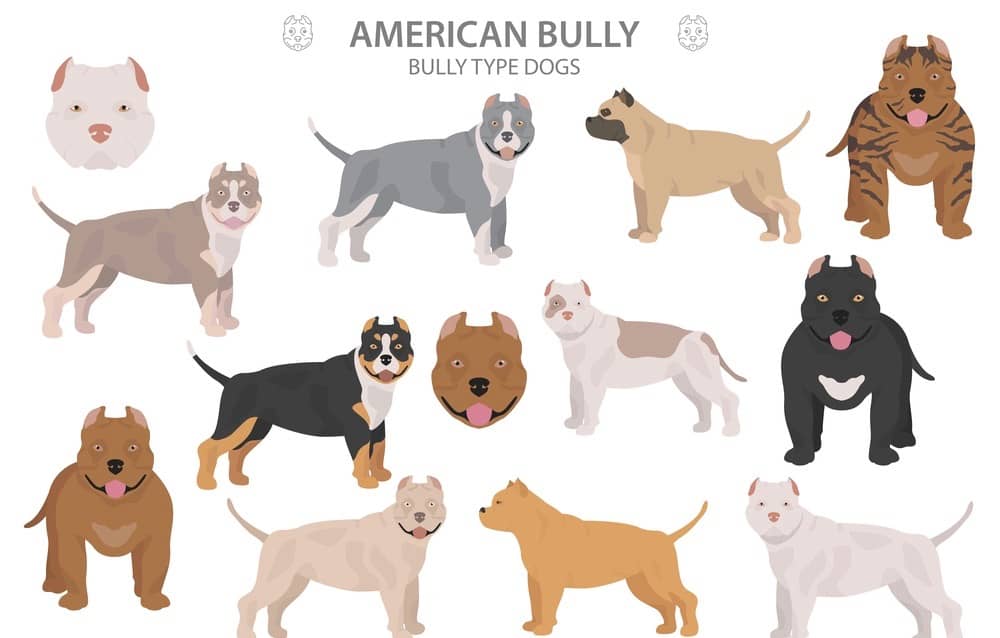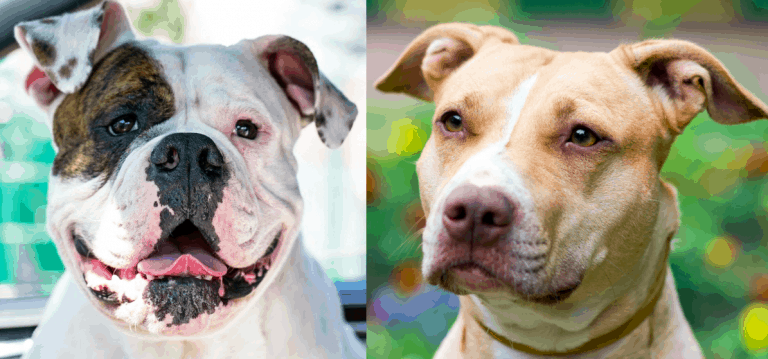American Bully XL – An Ultimate Guide To American Bully
Despite being a new breed, the American Bully XL is getting popular. The American Bully XL is a designer dog breed that is a very confident, gentle, loving, outgoing, and affectionate family member.
Knowing how to take care, maintain, and feed an American Bully XL is something that every potential owner must know. This is to ensure that they live a longer, happier, and healthier life.
This article will provide you with a comprehensive guide about the American Bully XL from their history, appearance, temperament, diet, exercise requirements, to the common health problems that affect them as a breed.
What Is An American Bully XL?
The American Bully XL is one of the four different types of the famous American Bully breed. The American Bully XL are bred as companion dogs and features a great temperament, distinctive face, and muscular body.
They also go by the names American Bully Pit, Bully Pit, or Bully Pitbull.
Why Is The American Bully XL Popular?

There are various reasons why the American Bully XL and other varieties of Bullies are becoming popular.
Even though they have been around for only several decades, this breed has become a favorite for everyday dog owners and many celebrities.
Pitbulls are already popular, and it is no surprise that the American Bully XL, coming from Pitbull, would inherit the traits that make them lovable.
Their most desirable trait is that they are the best guard dogs. They are loyal to their family members and their looks can prevent a criminal from messing around with them.
Additionally, American Bully XLs are calm, intelligent, and easy to train. They are great with children making them excellent family dogs.
Some people love the American Bully XL because of their compact and sturdy looks which make them look wonderful when photographed.
Types Of American Bullies
There are four different types of American Bullies registered by the American Bully Kennel Club. They include:
Standard
The Standard American bully has a blocky head with a medium to large muscular body. They look strong in proportion to their size and have a strong bone structure.
The male stands at a height of between 17 and 20 inches while the female stands at a height of around 16 and 19 inches from the withers.
The only difference between the Standard American Bully and the Pocket American Bully is height. The Pocket is one or two-inch shorter than the Standard, but the body type and build are similar.
Most people think that the Pocket American Bully is tiny because of the name ‘pocket’ but they are big. They are called ‘pocket’ because compared to other American Bullies, they are the smallest.
The male Pocket American Bully has a height of around 14 and 17 inches while their female counterpart has a height of around 13 and 16 inches.
XL

The American Bully XL has similar physical features, build, and body type as the Standard American Bully, but the only difference is they are slightly bulkier and stand a bit taller.
The male stands at a height of about 20 to 23 inches while the female stands at a height of about 19 and 22 inches.
Classic
The American Bully Classic is almost like the Standard American Bully, but the only difference is that they have a lighter frame. Overall, this means that their body mass is less compared to other Bullies.
The male stands at a height of between 17 and 20 inches while the female stands at a height of around 16 and 19 inches.
American Bully XL: History
The American Bully XL was bred around the 1980s and 1990s because the breeders wanted to create a great companion or family dog. The American Bully is a crossbreed between the American Staffordshire Terrier and the American Pitbull Terrier.
As the years pass, breeders have experimented crossing the breeds with the French Bulldog, American Bulldog, English Bulldog, Staffordshire Bull Terrier, and the Olde English Bulldogge.
Eventually, this has led to the amazing temperament and distinctive looks of the American Bully XL.
American Bully XL: Physical Appearance

The following are the key features of the American Bully XL:
Head
The American Bully XL has a large head with a broad skull. They have pronounced or chiseled muscles on the cheeks. The ears are high up on the head and they are usually left natural or cropped.
The eyes are shaped like almonds and come in different colors such as hazel, brown, or amber. The muzzle is closer to the face and is short or medium in length.
The nose comes in different shades like brown, black, Isabella, or blue.
The jaw is well-defined, and the lips have minimal looseness.
The face is wrinkly like that of a regular Bulldog and the wrinkles become clearer as they grow.
Body and Legs
The neck of an American Bully XL is heavy and muscular with a slight arch. Their rounded feet faces forward while their forelegs are sturdy and straight.
They have rounded ribs with a broad and deep chest that looks filled in. The back slightly slopes from the withers.Their body is heavily muscled and square.
Coat and Pattern
The pattern and color of an American Bully XL vary. Usually, the coat is straight, short, and glossy which is either stiff or soft. The thickness is average, not thick, and not thin.
Coat colors can be sable, brindle, black, red, silver, blue, gray, cream, Isabella, brown, or fawn.
American Bully XL: Temperament
Apart from the appearance, one thing dog enthusiasts and breeders love about the American Bully XL is their temperament. They are a lovable, friendly, and loyal dog that likes pleasing their family despite their ferocious looks.
The American Bully XL is a powerful dog but is extremely gentle and lively. It is rare for an American Bully XL to display aggressive behavior which is considered an undesirable trait.
If they are aggressive, the chances are high that they have a non-Bully dog breed in their lineage.
American Bully XL: Life Expectancy

All types of American Bully can live up to 10 to 12 years if they are well taken care of. 12 years is a moderate lifespan considering other breeds of dogs can live up to 15 years.
To ensure that your American Bully XL lives a long and healthy life, it is important that you are aware of the health problems that affect this breed.
Also, provide your American Bully XL with a balanced and complete diet as well as adequate exercise.
American Bully XL: Diet and Supplementation
If your American Bully XL is under the age of one year, it is best to feed them a diet that is high in protein and fat. Ideally, the protein content should be 30% or higher and the fat content should be 20% or higher.
Ensure that the food is high in quality with no possible allergens for your puppy.
Proper nutrition will ensure that your American Bully XL is healthy and that their muscle and bone growth is supported.
Premium-quality Dog Food
Most dog foods are meat-based and when selecting food for your American Bully XL ensure that the top ingredients are made of meat and should meet all your puppy’s nutritional needs.
There is plenty of dog food in the market ranging from cheap to expensive, so you will find one that fits your budget.
Ensure that you read the list of ingredients and reviews before buying any commercial dog food. Some of the quality brands for sourcing the food for your American Bully XL are Taste of the Wild, Orijen, and Acana.
Raw Food Diet
Raw food means serving your American Bully XL uncooked meals. The food includes raw meat such as lamb, turkey, salmon, or organ meat. It also includes certain fruits, vegetables, and even eggs.
Raw food diet contains most nutrients that your American Bully XL needs. If you choose this diet for your dog, ensure that all the foods are from organic sources.
Most dog owners choose the raw diet because the food is not processed and does not contain any preservatives or chemicals that may harm their dog.

The raw food diet improves the immune system of your dog and increases their longevity. It also helps with reproductive health, allergies, and improves the shoulder and neck muscles. When your dog chews raw food, their gums and teeth health is improved.
The downside of raw food diet is that they can contain dangerous bacteria such as E. Coli and Salmonella which can be harmful to your American Bully XL.
Before feeding your dog this diet, consult with your vet or breeder to ensure that you have enough information.
Homemade Meals
The best thing about feeding your American Bully XL homemade food is you know what goes into it. Homemade food can be made from meat, fruits, vegetables, or combining all of them.
Do your research to know the type of homemade food your dog will thrive in and ensure that it contains healthy ingredients.
Common foods include raw bones, meat, soup broth, meat stews, or any other meals that are high in protein.
The downside of homemade meals is that it takes time to prepare, and you have to find the right balance for all the nutrients that you should include in the meals.
Before feeding homemade meals to your Bully, consult with a professional to help you create a healthy and balanced diet that will ensure your dog is flourishing and growing to be healthy and strong.
You can find recipes online from American Bully owners who have used this route in providing nutrition for their dog.
Supplementation
Mineral and vitamin supplements are used for certain requirements in dogs such as enhancing eyesight, cognitive skills, bone strength, brain development, coat, and skin maintenance.
However, this does not mean that you should add supplements to your dog’s diet. It is crucial that you do extensive research on the right types of supplements for your dog as well as their need.
This is because an excess in any of these minerals and vitamins can affect the health of your Bully.
Additionally, supplements that contain steroids for growing muscle can have side effects in the long term such as weight gain, diabetes, alopecia, clotting disorder, aggravated allergic reactions, and weakened immune system.
Supplements are beneficial to your dog if they are used to fulfill the deficiencies in their diets. Typically, if your Bully feeds on homemade or raw food diets, they need supplements.
This is because these diets are not nutritionally balanced, unlike the branded dog foods. Adding vitamins and minerals to these diets will balance the deficiencies.
Supplements are also important if your Bully has underlying medical issues that need specific supplements such as dermatosis and osteoarthritis.
American Bully XL: Exercise and Training

For American Bully XL to thrive, they need plenty of exercises. This is because physical activity will soothe any digestion issues as well as any destructive behavior.
Exercise will also keep your dog agile and active while helping them maintain a healthy weight.
The physical exercise that your American Bully XL needs should match your lifestyle as they require someone to interact with and direct them to play, exercise, or do an activity. To ensure that your dog’s energy is fully utilized, give them at least one hour of exercise.
- The following are the basic exercises that you can do with your dog:
- A brisk walk around the park or your neighborhood at least once or twice daily.
- If your Bully needs to lose weight, stair climbing is great exercise.
- Swimming is great because it does not cause friction on the joints and works the entire body.
- Playing fetch is another interactive exercise. Use their favorite toy to make it fun.
American Bully XL are intelligent dogs, and it is advised that you start training them when they are young so that they know what acceptable behavior is and what is not.
When training your Bully use positive reinforcement, be consistent and firm with your commands as well as socialize and expose them to other animals.
The following training is recommended for your Bully:
Behavior training – this involves socializing your Bully to make sure that they act appropriately when around other people or pets.
This training will also help your dog to allow themselves to be picked up or handled. Although American Bull XL are friendly dogs, they need proper behavior training when they are still young.
Crate training – find a crate that is neither too small nor too big. Coax them with treats and food and feed them inside while keeping the door open.
Do not force them inside and you can close the gate when your dog feels secure. Begin with shorter periods then slowly increase the time they spend inside the crate. At the end of the training, your Bully should be able to fall asleep comfortably in the crate.
Potty training – when your Bully is around the age of 4 months, start potty training because they now have bladder control.
Look out for circling, whining, barking, or sniffing around, as your puppy may want to relieve themselves.
When you notice any of these signs, take them to outside or designated spot then reward them with a positive affirmation or treat after they have relieved themselves.
American Bully XL: Grooming
American Bully XL does not need much grooming because the length of their hair is short to moderate. What they need is occasional brushing of their coat to make sure it stays clean and healthy.
Smooth out their coats using a firm bristle brush. You can also bathe or use dry shampoo to keep the coat clean.
American Bully XL needs a bath once every two weeks because too much bathing can strip their natural oils. Ensure that the shampoo you are using does not cause any allergic reactions in your dog.

Brushing your Bully’s teeth is important to manage bad breath and keep your Bully safe from diseases, infections, and tooth decay.
Ideally, you should brush your Bully’s teeth daily but one to two times per week is also beneficial. Ensure that you use toothpaste and toothbrush for dogs so that their teeth are brushed properly.
Give your dog dental chews as they keep them mentally occupied and their teeth clean.
Trim your Bully’s nails properly using clippers to avoid over trimming which can be painful for your dog.
American Bully XL: Ideal Living Condition
An ideal home for an American Bully XL is one with a large yard so that they can run around making it easier for them to exercise because they have plenty of energy. American Bully XL can also do well in an apartment if their exercise needs are met.
When socialized properly, they can live well with other pets and children. If you have children, never leave them alone with the dog and ensure you supervise them.
American Bully XL: Vaccinations and Vet Care
Your American Bully XL is considered a puppy until the age of six months. When they are 5 weeks old, you can start giving them their vaccinations which are normally spaced out every three weeks. They are ready to get their rabies shot when they are six months and above.
Your bully can get booster shots when they reach the age of one year. For deworming, they need to be checked every three months to make sure that they do not have worms. Most puppies can receive heartworm prevention as early as four months.
American Bully XL are predisposed to certain health problems, therefore, visits to the vet once or twice per year will allow for early diagnosis and treatment.
As your Bully becomes a senior, visits to the vet should be more frequent because they have different needs compared to when they are puppies.
Common Health Problems For American Bully XL
The following are the most common health issues that you should watch out for as an American Bully XL owner:
Cherry Eye – this is the most common health issue affecting the American Bully XL. This condition happens when the structure holding the nictitating membrane (third eyelid) in place moves.
Entropion – this condition occurs when part of the eyelid rolls inward.
Skin Problems – the most common skin issues that can affect your Bully are eczema and seborrhea. Eczema can be caused by hormonal issues, extremely hot weather, and allergies while seborrhea causes your dog’s skin to be too oily or too dry.
Another skin condition is Acute Moist dermatitis or ‘hot spots’ which cause itchy, red, and hairless lesions. It can be caused by parasites, flea bites, and even food.
Canine Hip Dysplasia – this condition occurs when the joint and ball socket does not fit into the hip socket because of the deterioration of the cartilage that protects the femoral head.
If your dog is limping when walking, hesitant to run or jump, having difficulty going up and down the stairs, or has a bunny hop gait, they could be suffering from this condition. Take them to the vet for an X-ray.
Allergies – American Bully XL can get allergies from certain products which can cause them to start biting, scratching, or even sneezing.
Some allergy triggers are mold, pollen, dust, or food such as meat, grain, or fish. To avoid allergic reactions, you must identify the cause and keep your Bully away from it.
Heart Disease – Bullies are prone to getting congenital heart issues which can take years to show.
Some heart conditions are genetic while others are caused by obesity or heartworms. Giving your dog heartworm prevention medicine and managing their diet can help minimize the condition.
Other health conditions include Hypothyroidism, Cataracts, heat intolerance, Progressive Retinal Atrophy, Atopy, and Ichthyosis.
How Much Does An American Bully XL Cost?
On average, the cost of an American Bully XL is between $2500 and $5000. The price depends on the location, breeder’s reputation, bloodline, health, genetics, and the quality of the puppy.
The American Bully XL is more expensive than the standard Bullies because they are less common. The pedigree of an XL Bully also contributes to their cost. For instance, a champion bloodline can be three times or more than the average selling price.
Depending on the accomplishments, structure, pedigree, and quality of the bloodline, you may end up paying up to $10,000 for an American Bully XL.
Guidelines When Buying An American Bully XL
- Keep the following guidelines in mind to ensure that you get a healthy American Bully XL:
- Find a breeder that is affiliated or registered with the American Bully Kennel Club or the United Kennel Club.
- Avoid buying from puppy mills, pet stores, pet brokers, or online.
- A good breeder will be willing to show you the puppy’s mother or father.
- The breeder should be able to provide you with health papers and certificates to ensure that the puppy is healthy.
- If possible, ask past clients what they think about the breeder.
- Ensure that the puppy is well-socialized.
- A good breeder should not hesitate to answer all the questions you have about the puppy.
- Adopting an American Bully XL
You can own an American Bully XL by adopting one if you have insufficient funds. Adopting an American Bully XL is cheaper compared to purchasing one. Also, you will be helping a dog who needs a new home.
It is important that you sign up on the waitlist so that you are notified when there is one. Remember that you can either get an older dog or a puppy.
American Bully Bloodline
Reputable breeders spend years ensuring that they produce puppies that further the bloodline of the Bully while others are simply breeding Bullies for the same of money.
Some of the established and most popular bloodlines for American Bullies are Watchdog, Razor’s edge, Royal, and Gotti or Gotty.
The two most popular bloodlines of the American Bully XL are Remy Martin and Kurupt Blood Panic. Also known as the Remyline, Remy Martin is the most prolific and has sired over 1000 puppies to date.
Kurupt Blood Panis, also known as ‘Freak,’ has produced XL bullies that have a laid-back temperament and are friendly. His head is about 27 inches.
American Bully XL FAQs:

Is American Bully XL A Great Family Dog?
Yes, they are one of the friendliest breeds and were bred for companionship. They are confident around new people, obedient, strong, good-natured, and amusing dogs to have in your home.
This breed has the outgoing and sociable temperament of the American Staffordshire Terrier and the friendliness and stability of the American Pit Bull Terrier.
Is American Bully XL Good Around Young Children?
Yes, they are fantastic dogs around children. They are known as the ‘nanny dogs’ because of their tolerance and patience. Since they can tolerate pain, American Bully XL will not mind if children tug their tails or ears.
They are submissive as long as they know the children are part of their pack and are well socialized. They can manage a bit of roughhousing. However, it is wise to supervise when your Bully is playing with the children.
Is It Safe To Feed Your XL Bully Fruits?
Yes, but certain fruits may be harmful to your dog’s health. When introducing fruits to your dog for the first time, do it slowly to avoid indigestion, diarrhea, or vomiting.
Recommended fruits include blackberries, banana, kiwi, blueberries, cantaloupe, apples, pears, strawberries, raspberries, and watermelon.
Fruits to avoid include lemon trees, orange trees, avocados, coconut, grapes, and raisins.
Is American Bully XL Good With Other Pets?
While they are sociable dogs, it takes some time for an American Bully to get used to other pets or dogs.
Again, you should thoroughly train and socialize your Bully when they are young so that they can adapt to new pets and dogs easily.
Is American Bully XL Dangerous?
No, American Bully XL are very friendly and will not show any aggression to their families unless they are threatened.
They also do not attack other dogs or children out of the blue. Given that they are properly socialized and trained, American Bully XLs are curious, outgoing, friendly, and will not show any kind of aggression.
Is American Bully XL Recognized By The AKC?
No, they are not recognized by the AKC.
This is because the American Bully is a new breed, but they are recognized by the United Kennel Club and American Bully Kennel Club.
How Many Puppies Does American Bully XL Have?
The average number of puppies that an American Bully XL can have is between 4 to 8.
American Bully XL vs XXL
Technically, the American Bully XL and XXL are the same. The height of XL Bullies is between 20 to 23 inches and Bullies taller than that fall under the category of XXL or Giant Bullies.
American Bully XL vs Pitbulls
Pitbulls are breeds that descend from bulldogs and terriers while American Bully XL is a type of American Bully which is a result of breeding American Staffordshire Terriers and Pitbull Terriers.
Pitbulls weigh between 30 and 60 pounds with a height of between 17 and 21 inches while the American Bully XL is larger and weigh between 80 and 150 pounds with a height of about 20 to 23 inches.
Historically, Pitbulls were bred as fight dogs, and are agile, intelligent, and obedient dogs. American Bully XL is known for their aggressive stance and muscular physique, but they are gentle and make great family companions.
Final Words
The American Bully XL is a wonderful breed, and whether you are serious about owning one or just curious about them as a breed, there is no denying that they are worth the effort and investment.
This breed is great with children and a fantastic and loyal family dog.
If you are a dog lover and want one to be part of your family, the American Bully XL is a great option.
All they need is love, care, a balanced diet, adequate exercise, and regular visits to the vet to ensure that their health is optimal so that they can live longer and happier.






